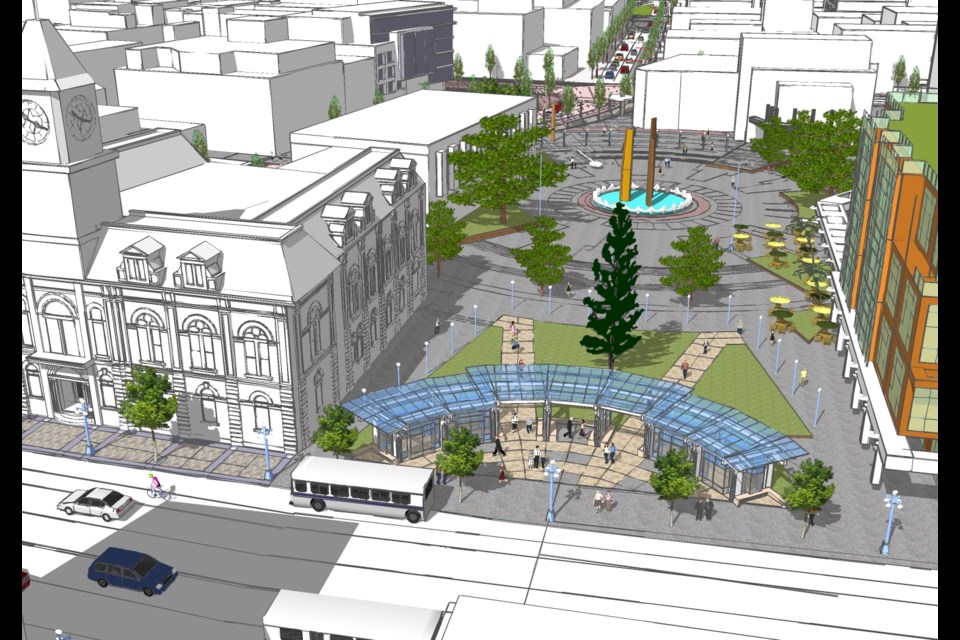Diverse views regarding the need for updating Centennial Square provide for healthy discussion, and bring to mind significant opportunities. Here is another point of view.
It is true, particularly during evenings and winter days, that Centennial Square can be sadly dejected and underused. Improvements are overdue. However, take caution not to “throw out the baby with the fountain pool.” Instead, aim for better times ahead.
Centennial Square was a visionary initiative in the 1960s. It falls in the category of Canadian Centennial Architecture, which is currently receiving scholarly attention as a distinctive national oeuvre.
Remarkably, half a century ago, Victoria celebrated more centennials and produced a greater variety of centennial projects than any other city in Canada. These include:
• 1958 — centennial of creation of the Crown colony of British Columbia;
• 1962 — centennial of the chartering of the City of Victoria;
• 1966 — centennial of the union of the Crown colonies of Vancouver Island and British Columbia;
• 1967 — centennial of the Confederation of Canada; and
• 1971 — centennial of the entry of British Columbia into the Canadian Confederation.
Each centennial was prominently and formally observed in Victoria, with many centennial project legacies.
Centennial Square made an apex contribution to Victoria’s distinctive array of mid-century architecture and urban design. Fifty years ago, it drew international attention: Somehow, a small provincial city undertook an initiative of a scope and standard that surpassed contemporary urban design projects in more prominent cities.
In an optimistic time, its design was intended physically and metaphorically to be open, to draw from all quarters. The intricate fountain provided an elegant centrepiece, a gesture of regional amity and civic cultivation. Credit the authors — a team of local designers noteworthy in their generation: artist Jack Wilkinson, urban designer Rod Clack, architect Alan Hodgson, landscape architect Clive Justice.
In the right circumstances, Centennial Square can ring as a successful public place. For well-organized festivals and civic ceremonies such as the city’s 150th celebrations, the square comes to life as an effective, memorable downtown centre. But the obverse can also be all too evident: On many days, the square, in its current state, underperforms, a sad diminishment of its better self.
However, would elaborately reworking the plaza and tearing out the fountain really guarantee revived vitality? Better to expend budgets and ideas on unfulfilled and overlooked objectives, and enact assured strategies to bring the everyday activity and the lift in intensity that are lacking:
• Replace the aged, seismically worrisome parkade with a mixed-use public cultural and amenity building. For decades, a new library has been identified as a prime aspiration.
• Consider multiple uses — any combination of library, art gallery, public lecture hall or children’s features — and add supporting municipal or commercial offices above, with parking placed underground, or alternatively, create specialized affordable housing. With imagination, such a new building could reuse elements of John Di Castri’s stylish mid-century architectural design.
• On the north side of the plaza, incorporate a large café or restaurant/nightclub, with its own south-facing outdoor dining and entertainment terrace. Such dining terraces are common in European and Latin American squares.
• Include ample public washrooms, oriented to the civic plaza, as well as the restaurant and cultural uses, open and monitored all days of the week and into the evening.
• Extend the Government Street mall and design a compelling connection to Centennial Square. Strengthen Government Street as a strategic link to draw visitors from the Inner Harbour.
• Introduce an integrated system of signs and maps, including orientation to the potential core visitor triangle being formed between the Inner Harbour, the harbour pathway and bridge and Centennial Square.
• Refurbish the fountain. Consider a complementary adaptation to incorporate a children’s waterpark feature by simply placing a removable metal grid deck over the pool and reworking the fountain jets.
• Add to the Douglas Street side a combination bus shelter/pergola, with refreshment services.
• Stage incremental repairs and improvements to properly restore the square, and to enhance functionality. Ensure public dollars are spent well on cost-effective advancements and innovations, of enduring quality.
• Repair paving patterns, design brick seating planters around trees with upheaving root bases. Use produced-in-Victoria furnishings, rather than catalogue benches. Factor in lively and resonant civic art, both temporary and permanent.
• Ensure changes are creative, yet integrated with the original design, as were the excellent recent additions for the Olympic Spirit Square by urban designer Bill Pechet and landscape architect Joe Daly.
In my experience, cities that respect their full histories, stewarding and repurposing the best of all eras rather than disposing of the art and culture of previous generations in favour of trendy replacements, will accumulate more depth of authenticity and character to reward residents and new admirers.
Drawings were generated, during my former service as Victoria senior planner-urban design and architect, to summarize such potential ideas and policies, and to help move forward long-standing strategic city objectives for the square’s future.
Update and enhance Centennial Square, but resist the impulse to cannibalize a historically significant Victoria urban design landmark.
Chris Gower, who grew up in Victoria in the Centennial era, is an urban-design planner.



